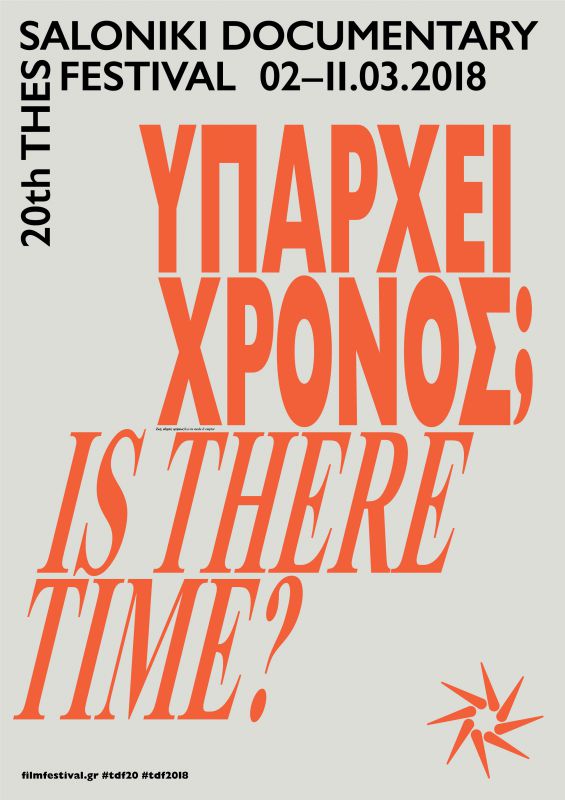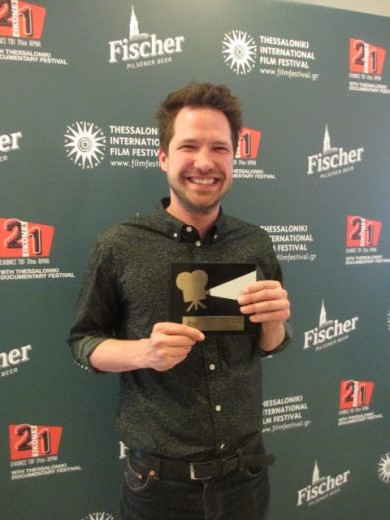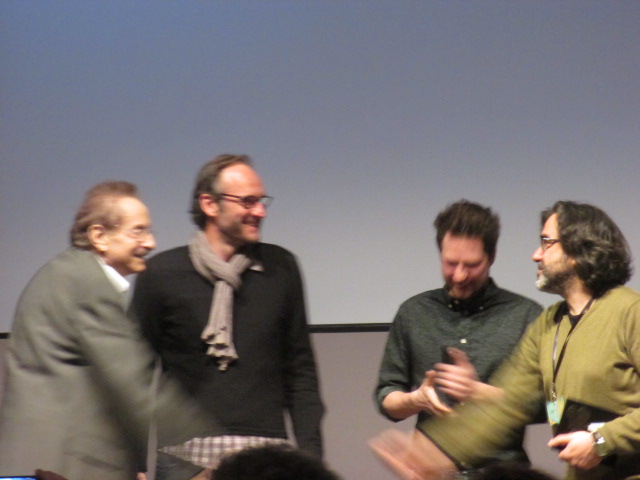|
|
||
|
Pro Tools
FILMFESTIVALS | 24/7 world wide coverageWelcome ! Enjoy the best of both worlds: Film & Festival News, exploring the best of the film festivals community. Launched in 1995, relentlessly connecting films to festivals, documenting and promoting festivals worldwide. Working on an upgrade soon. For collaboration, editorial contributions, or publicity, please send us an email here. User login |
5 Broken Cameras: interview with filmmaker Guy Davidi
During the 14th Thessaloniki Documentary Film Festival, by far one of the most poignant films for me was the ensemble film: ‘5 Broken Cameras’ by Israeli director Guy Davidi and Palestinian director Emad Burnat. The story is about Palestinian farmer/filmmaker Emad Burnat who feels it his purpose in life to film the events taking place in his Palestinian village Bil’in while Israeli soldiers take over the village to build Israeli settlements. What starts as peaceful demonstrations from the Palestinians turns into aggressive attacks from the Israeli invading soldiers and all the while, Emad (and Guy Davidi behind the camera) film the events with camera #1 in 2005. But the soldiers forbid the filming and shoot the camera down. During the course of the film, 5 cameras are shot down, twice injuring Emad while filming. ‘5 Broken Cameras’ is the story behind the footage taken with these now broken cameras and the lives of the filmmakers, protestors and families involved.
An interview with filmmaker Guy Davidi:
ME: Can you describe your very first experience with filmmaking?
GUY: I was born in Jaffa. Ever since I was a child I wanted to tell and write stories. Already when I was 14 years old, I started enthusiastically to write a novel, though it was never finished. At the age of 16, I discovered cinema and started to make short films in my high school cinema course. One of the first films that influenced me, and is still one of my favorite films, was John Cassavetes’ ‘A women under influence’ I think seeing the film convinced me that there is something to explore through films. Making films in high school were the first fiction films I have made, and this filmmaking period was great even though it was completely escapist filmmaking dealing with love and relationships without having any general context. But I knew this was just the start. So when I was supposed to go to the army, like every Israeli must when he gets to be 18 years old, I knew what I wanted to do in life. GUY CONT'D: For me, cinema was a safe home in a very complex and often oppressive and violent environment. I remember in high school we had a day tour of the army corps. It was part of the regular school program to organize tours to different army units so that they could tempt us so that we will choose the unit where we would serve in our upcoming military service. This experience was disturbing. Even though I did not have a very developed political awareness at that age, I immediately felt dizzy and was revolted by the idealization of violence. At the end of that tour, there was a spectacularly ridiculous screening in the unit’s cinema hall. And on the screen, there was a propaganda film of the army corps. I distinctly remember having tears in my eyes as I had an important understanding that I should shoot truthful and sincere films and not shoot people. With this, I felt strangely at home in this violated cinema hall.
ME: How did you first come to Bil’in and meet Emad? What was the most memorable day of shooting like?
GUY: I was in Bil’in as an Israeli sympathizer right from the start. I made there all my first documentaries, and throughout 2005 I even stayed there for a few months to create my first feature documentary ‘Interrupted Streams’. It was not something easy for me or the villagers of Bil’in to accept since I was an Israeli staying in the village during the weeks and not just for the Friday demonstrations. They feared by accepting this they are normalizing relation with Israelis. Also these were politically uncertain times as the Hamas just won the election and no one knew what would happen. During this period the soldiers started entering into the village at night to arrest people, many of them were young children. Every night the soldiers came. Abdullah, the guy who hosted us (me and Alexandre Goetschmann - a Swiss co-director of interrupted streams) was knocking on the door saying: “Jesh, Jesh!” (Meaning army) and being the only Israeli and also with a camera, I had to go out and film the soldiers, even though it wasn’t part of the film we were doing with Alexandre at that time. I remember many times Emad and I were filming side by side the arrests. Some of this footage is in the film, mostly Emad’s footage of course but some of mine as well. One night there were many arrests and the villagers were angry and they came out towards the soldiers shouting at them “Allahu Akbar” the soldiers were naturally scared and started aiming the guns directly, it was clear it’s going to explode. I was moving around from place to place shouting in Hebrew “Don’t shoot! There are Israelis!” and luckily no one was shot. On the radio the day after, the news reports were all saying that according to the army spokesman there was a night demonstration in Bil’in and there were 40 Israelis, although I was the only Israeli there that night.
ME: What was your view of Emad?
GUY: I know him very well, as we all did, meaning the Israeli activists. Emad started filming in 2005 when I came to Bil’in. He was doing it for news agencies and TV channels. As a cameraman that was from inside the village he could get important footage when all the other journalists left. Many of us helped him by brining him tapes or fundraising for cameras or repairing the cameras, especially Yisrael Puterman who is his friend and the one who also filmed Emad when he was shot by the bullet. When he was wounded in the accident many of us payed visits in the hospital where he was hospitalized. Yisrael offered me to do a film with Emad already in 2007, when he was studying in my video course at that time, but I thought that it is impossible to make another film on Bil’in’s movement since already there were other films, and above all: ‘Bil’in, my love’ by Shai Carmeli Pollack. GUY CONT'D: For years Emad didn’t think of doing a film, but I think after many filmmakers passed through Bil’in and used also his footage the urge came as well to make his own film. So In 2009, Emad approached me directly to make a film together. His idea was to focus on two characters he was filming- Adeeb and Phil. Phil was killed during the resistance and Emad wanted to create a film that would memorialize Phil. The film was developed through the Greenhouse Program with Dutch filmmaker John Appel as a mentor. When I first looked at the footage I wasn’t sure I wanted to make another film on the same subject of the resistance. I knew Emad had a visual natural talent. I even used some of his footage in my previous film ‘Interrupted Streams’, but I didn’t want to do the same story of an objective movement again. Then in one of the images I saw an old man I didn’t know climbing on a military jeep and blocking it from moving. I asked Emad who that was and what he was doing? Emad explained that the man was his father and he was blocking the jeep from taking his brother to jail. And then it struck me that from this moment we had the makings of a new film that would tell the events the way Emad experienced them as a cameraman. We could use all of his home videos footage to include his perspective as a family man.
ME: How was it for Emad making this film?
GUY: It was a very hard decision for Emad to make a personal film. This is not something people here can understand easily. It means exposure of some difficult moments like his arrest or his accident. Emad was also concerned how people in the village would react when they saw the whole movement being covered from a personal perspective and that people might feel disappointed since they are left outside of the film.
ME: What was your part of the filmmaking?
GUY: I was the Storyteller. For Emad the amounts of footage (more then 700 of tapes) were his life. And everything was mixed altogether. So I had to take the role to tell the story. The most important decision I took was to convince Emad to make it a personal film and to look for all the homemade footage. Emad thought his role in the film wasn’t important, but I thought his role as a camera-man was the main story. Later on when I discovered that Gibreel was born at the same time as Bil’in’s resistance, I came up with the idea that he should also become a character in the film, and since Emad had so much family footage, that was possible too. Emad became not just the role of a cameraman, but also that of a father. Another sensitive challenge was to use Soraya’s footage. There wasn’t much, so from 2009 to 2011 I asked Emad to concentrate on looking for family footage of the family and Soraya. So scenes like Soraya asking him to stop filming, or Gibreel is going to the demonstrations came during this time and allowed us to construct the family-personal narrative. After this footage was received I also looked for important footage of other cameramen. We had to use other footage because I wanted to create scenes with different points of view over the events. A lot of important footage came from other cameraman, like Phil’s death shot by 2 cameramen, Dab’a getting shot that was actually shot by a 14 year old Palestinian girl. GUY CONT'D: It was interesting to see in the footage how the different camermen have different points of view: Jonathan Massy shot a lot of meetings, Yisrael Puterman concentrated on the action, and footage of me and Alexandre Goetschmann was all we had of the construction of the settlment that no one else filmed. So we had the benefit of having a large spectrum of the reality. Then came the editing and it started by writing the script and the texts. I think it was easier for me to write the texts because I spent so much time in Bil’in. I could have developed an intuition to how Emad experienced things. The inspiration for the text came from Emad’s footage and also my experiences, as well as from other people in Bil’in who I met. Before it was translated from English to Arabic and recorded at the end of the editing, Emad took it and made some changes to fit it to his language. GUY CONT'D: After almost 2 years of work on the pre-editing and narration, I had the chance to work with Veronique Lagoarde-Segot in Paris and to create the final film with her talant and sensitivities. Emad joined us for the final week to record the last narration. After that, the film was ready.
ME: What was your single biggest challenge in developing and producing this project?
GUY: When we started this film I knew we would be criticized for doing this film together. Emad would be asked why did he choose to make it with an Israeli and me with a Palestinian. The actual differences were something we couldn’t avoid. We had different privileges and different complications and we had to learn to use them in a constructive way, though they have a tendency to complicate things. We have different cultural backgrounds, life experiences and accessibility to the world and also there are different expectations from us, especially because of our identities. GUY CONT'D: When I decided to make this film, I thought that this should be as intimate and personal as can be. It was also politically much more interesting for me to be in the role of empowering Emad, and encouraging his voice to be heard. At the end, that was the only way we can tell this story in a new and emotional way. For Emad, this wasn’t a simple decision. The exposure can be flattering but also risky. Moments like his house arrest, showing his vulnerability were not easy for him to accept. He had also to accept my interpretations of him and allow me to construct a character from his life, which isn’t necessarily the same as he is in real life. At last, as this film should be focused on Emad’s narrative, my role would be much more ambiguous for the audience. GUY CONT'D: Another challenge for me was giving up on my space for Emad. However, since the footage existed I was the one to create the film, I had to be ready to put Emad’s work in the center knowing that my work wouldn’t be entirely revealed. I was to be a kind of Cyrano de Bergerac, but I think that all storytellers actually find themselves in the same role. It’s the characters that should be in the front and not the filmmakers.
-by Vanessa McMahon; April 15, 2012
Guy Davidi
16.04.2012 | Thessaloniki's blog Cat. : 5 Broken Cameras: interview with filmmaker Guy Davidi Interviews
|
LinksThe Bulletin Board > The Bulletin Board Blog Following News Interview with EFM (Berlin) Director
Interview with IFTA Chairman (AFM)
Interview with Cannes Marche du Film Director
Filmfestivals.com dailies live coverage from > Live from India
Useful links for the indies: > Big files transfer
+ SUBSCRIBE to the weekly Newsletter Deals+ Special offers and discounts from filmfestivals.com Selected fun offers
> Bonus Casino
User imagesAbout Thessaloniki Mcmahon Vanessa Mcmahon Vanessa Vanessa McMahon Covered the 13th and 14th, and 16th edition. Through its tributes, it focuses both on discovering filmmakers with a unique cinematic point of view, and on the internationally recognized for their contribution to documentary. Contributions from Buno Chatelin http://tdf.filmfestival.gr/default.aspx?lang=en-US&loc=6&page=760 View my profile Send me a message My festivalThe EditorUser contributions |




























